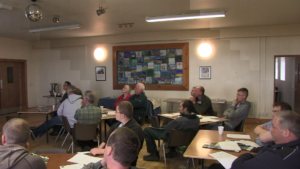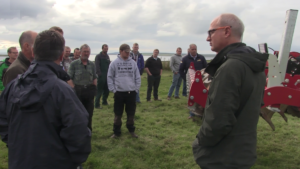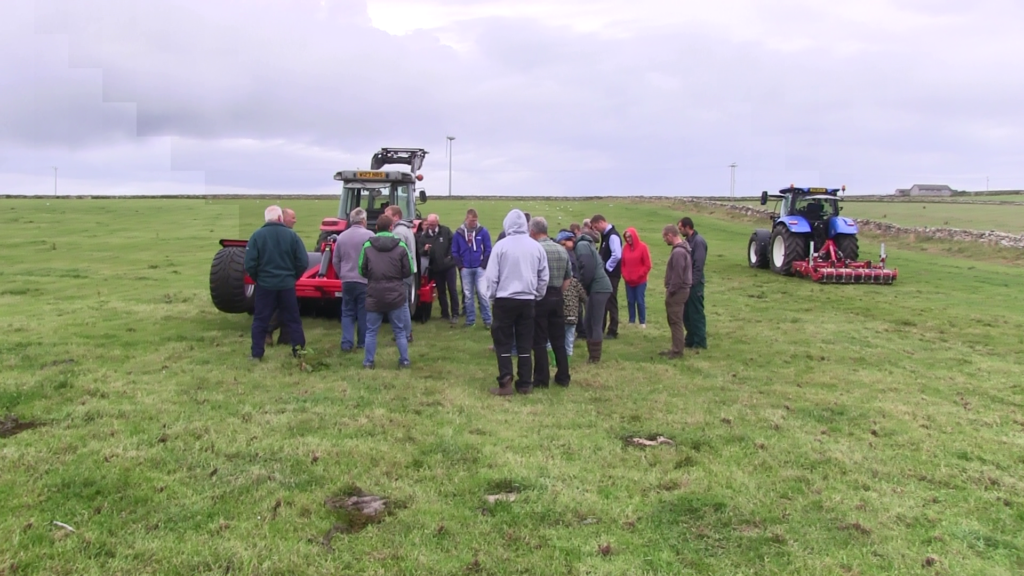Orkney Soil & Nutrient Network: 1st meeting event summary
20 August 2018This was the first meeting of the Orkney Soil and Nutrient Network Farm based at Midgarth in Stronsay.
The meeting focused on the soil, slurry and FYM analyses carried out on the host farm. The results were discussed in the context of what to do to raise pH, P and K levels where a ppropriate using the available resources on the island including the calcareous shell sand. Neutralising values were also highlighted as a means of which to compare different liming materials.
ppropriate using the available resources on the island including the calcareous shell sand. Neutralising values were also highlighted as a means of which to compare different liming materials.
Soil structure, texture and compaction was also discussed and actual examples of good and poor soils were on-hand to show the attendees. This led seamlessly onto an in-field demonstration of two items of machinery which alleviate compaction issues in grassland. Both were deemed to be successful in their own right at enhancing the soil structure in the fields in which they were used.
Key points from this event
- Use the neutralising value (NV) of liming materials to help determine which product to use to achieve and maintain target pH levels.
- Be aware of how and when to take soil samples, avoiding areas where lime or FYM may have been stored in the past e.g. near gateways.
- Try and soil sample the fields on your farm at the same time of year, ensuring there is a significant break between the application of any fertiliser and taking the actual sample.

- Consider analysing the slurry and FYM on farm to ascertain accurate N, P and K content as using book values can vary significantly for what you may actually be applying.
- Whilst there are many different machines on the market to alleviate compaction, they will not all do the same job. Ensure you identify where your compaction issue is within the soil profile before selecting an appropriate machine to alleviate it at an appropriate time.
Download the presentation files used during this event, delegate pack information available to take away on the day and other relevant information using the links below.
This was the first of three meetings that will be held as part of the Orkney Soil & Nutrient Network. There are 11 other host farms across Scotland all taking a ‘before and after’ look at how to protect and improve farm soils and make best use of both organic and inorganic fertilisers, saving money, benefiting yields and improving farm efficiency and resilience. Find out more here.
- Orkney Soil & Nutrient Network 1st meeting – Bill Crooks presentation slides
- These are presentation slides used by Bill Crooks during the first meeting of the Orkney Soil & Nutrient Network. Bill discussed nutrient management and soil analysis, including the topic of the use and neutralising value of different limes.
- Topics: Soils
- Orkney Soil & Nutrient Network: 1st meeting presentation slides – Gavin Elrick
- These are the presentation slides used by Gavin Elrick during the first meeting of the Orkney Soil & Nutrient Network. Gavin's presentation included soil structure, compaction and drainage.
- Topics: Soils
- Valuing Your Soils – Practical Guidance for Scottish Farmers
- This brochure includes useful information about Scotland's agricultural soils and practical advice outlining the upfront financial savings and business benefits of better soil management and the efficient use of resources. Action and problem-specific 'field-sheets' are designed for busy farmers with limited time for reading.
- Topics: Soils, Climate Change, Water Management and Crops and Soils
- Visual Evaluation of Soil Structure (VESS) Score Chart
- This is a downloadable copy of the Visual Evaluation of Soil Structure (VESS) score chart for use in-field.
- Topics: Soils
- Technical Note (TN656): Soil Information, Texture & Liming Recommendations
- • Web based access to information on your soils on your farm is described. • Soil texture classes of mineral soils are described and identified by hand texturing. • Liming recommendations for different soils and managements are tabulated.
- Topics: Soils
- Farming For A Better Climate: Practical Guide – Alleviating Soil Compaction
- This Practical Guide gives some ideas on how to alleviate soil compaction.
- Topics: Soils
- Farming For A Better Climate: Practical Guide – Improving Soil Quality
- This Practical Guide concentrates on how we can improve soil quality to help us to adapt to climate change.
- Topics: Soils
- Practical Guide: Soil sampling I – How to take a soil sample
- This practical guide details what is required to take a soil sample for analysis that is representative of the area sampled.
- Topics: Soils, Climate Change and Water Management
- Practical Guide: Soil sampling II – Benefits to your business
- This practical guide details how soil sampling can benefit businesses by increasing productivity and create efficiencies on fertiliser inputs through better nutrient planning.
- Topics: Soils, Climate Change and Water Management
- Presentation – Improving drainage & structure for healthier soils event 24.08.17
- Topics: Soils and Water Management
- Practical Guide: Tyre Selection & Management
- This practical guide explains how to reduce soil damage, improve fuel usage and reduce overall green house gas emissions by selecting the correct tyre size, type and pressure.
- Topics: Climate Change
Sign up to the FAS newsletter
Receive updates on news, events and publications from Scotland’s Farm Advisory Service

